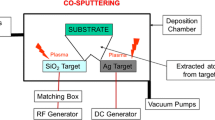Abstract
Silver nanocomposite materials were prepared by hydrolysis and condensation of tetraethyl orthosilicate (TEOS, Si(OC2H5)4) in the presence of diamminesilver(I) cation ([Ag(NH3)2]+). The obtained materials were investigated by transmission electron microscopy (TEM) and X-ray diffraction analysis (XRD). The morphology and size of silver nanoparticles inside the silica gel matrix were identified. TEM microphotographs of silica with nanosilver have shown that the particle size of the silver nanocomposite materials depends on the amount of nanosilver in the silica gel matrix. These materials were grafted on the surface of textile fabrics. Antimicrobial activity was studied by testing all obtained samples in vitro: gram-positive prokaryotes of the genus Staphylococcus (Staphylococcus aureus associated with skin and mucous membranes was used as test microbe) and gram-negative prokaryotes of the genus Escherichia (Escherichia coli associated with gastrointestinal mucosa was used as test microbe). The textile fabrics with different contents of silver nanocomposites have shown high antimicrobial activity against Staphylococcus and E. coli bacteria. The results of the present work have proved the possibility of applying these materials in the textile industry and engineering process.





Similar content being viewed by others
References
Beaumont, P. W. R., Soutis, C., Hodzic, A. (2012). The implementation of composite materials in engineering structures where total safety is of the essence. Journal Composite Materials, 19(5), 767–768.
Akkopru, B., & Durucan, C. (2007). Preparation and microstructure of sol–gel derived silver-doped silica. Journal of Sol–Gel Science and Technology, 43, 227–236.
Varvani-Fahani, A. (2010). Composite materials: characterization, fabrication and application-research challenges and directions. Journal Composite Materials, 17(2), 63–67.
Rangel-Porras, G., & Ramos-Ramires, E. (2010). Mesoporous characteristics of crystalline indium-titanium synthesized by the sol–gel route. Journal of Porous Materials, 17, 69–78.
Miyazaki, T., Ohtsuki, C., Tanihara, M. (2003). Synthesis of bioactive organic–inorganic nanohybrid for bone repair through sol–gel processing. Journal of Nanoscience and Nanotechnology, 3, 511–515.
Zelinski, B. J. J., & Uhlmann, D. R. (1984). Gel technology in ceramics. Journal of Physical Chemistry Solids, 45, 1069–1090.
Sanchez, C., & Ribot, F. (1994). Design of hybrid organic–inorganic materials synthesized via sol–gel chemistry. New Journal of Chemistry, 18, 1007–1047.
Aparicio, M., Jitianu, A., Klein, L.C. (2012). Sol–gel processing for conventional and alternative energy. Ser. Advances in Sol–Gel Derived Materials and Technologies
Klein, L. C. (2009). Sol–gel process for proton exchange membranes. Progress in sol–gel production. Key Engineering Materials, 391, 159–168.
Tanahashi, I., & Mitsuyu, T. (1995). Preparation and optical properties of silica gels in which small gold particles were grown by photoreduction. Journal of Non-Crystalline Solids, 181, 77–82.
Matsunami, N., & Hosono, H. (1994). Novel approach for synthesizing Ge fine particles embedded in glass by ion implantation: formation of Ge nanocrystal in SiO2–GeO2 glasses by proton implantation. Applied Physics Letters, 65, 1632–1635.
Shi, H., Zhang, L., Cai, W. (2000). Composition modulation of optical absorption in AgxAu1-x alloy nanocrystals in situ formed within pores of mesoporous silica. Journal of Applied Physics, 87, 1572–1580.
He, H., Wang, Y., Zou, Y. (2003). Optical properties of nanometre AgI–silica composite synthesized by a simple quenching method. Journal of Physics-condensed Matter, 15, 4869–4876.
Milosevic, M., Radoicic, M., Saponjic, Z., et al. (2013). In situ generation of Ag nanoparticles on polyester fabrics by photoreduction using TiO2 nanoparticles. Journal of Materials Science. doi:10.1007/s10853-013-7338-1.
Georgios, A., & Sotiris, E. (2010). Antibacterial activity of nanosilver ions and particles. Environmental Science and Technology, 44, 5649–5654.
Thanh, N. V. K., & Phong, N. T. P. (2009). Investigation of antimicrobial activity of cotton fabric incorporating nano silver colloid. Journal of Physics, 187, 1742–6596.
Shakhova, K. A., & Timin, A. S. (2012). Influence of hybrid materials based on mesoporous silica and silver nanoparticles on opportunistic microorganisms. II International Pirogov Scientific Conference of students and young scientists, 1, 32–33.
Cullity, B. D., & Stock, S. R. (2001). Elements of X-ray diffraction (p. 170). New Jersey: Prentice-Hall.
Marsich, E., Bellomo, F., Turco, G., Travan, A., Donati, I. (2013). Nano-composite scaffolds for bone tissue engineering containing silver nanoparticles: preparation, characterization and biological properties. Journal of Material Science: Material in Medicine. doi:10.1007/s10856-013-4923-4.
U.S. EPA. (2012). Nanomaterial case study: nanoscale silver in disinfectant spray (final report).U.S. Environmental Protection Agency, Washington, DC, EPA/600/R-10/081F
Rashid, A., Khaydarov, R. R., et al. (2009). Electrochemical method for the synthesis of silver nanoparticles. Journal of Nanoparticle Research, 11, 11193–11200.
Hashim, A. A. (Ed.). (2012). The delivery of nanoparticles. Croatia: InTech. ISBN 978-953-51-0615-9.
Pulit, J., Banach, M., Kowalski, Z. (2011). Nanosilver—making difficult decisions. Ecological Chemistry and Engineering, 18(2), 185–196.
Panyala, N. R., Pena-Mendez, E. M., et al. (2008). Silver or silver nanoparticles: a hazardous threat to the environment and human health. Journal of Applied Biomedicine, 6, 117–129.
Prabhu, S., & Poulose, E. K. (2012). Silver nanoparticles: mechanism of antimicrobial action, synthesis, medical application and toxicity effects. Nano Letters: International. 32.
Sotiriou, G. A., et al. (2010). Non-toxic dry-coated nanosilver for plasmonic biosensors. Advanced Functional Materials, 20, 1–8.
Erdem, K., & Yurudu, N. O. (2008). The evaluation of antimicrobial activity of fabrics impregnated with dimethyltetradecyl (30(trimethoxysilyl) propyl) ammonium chloride. Journal of Biology, 67(2), 115–122.
Singh, G., & Joyce, M. E. (2012). Evaluation of antimicrobial activity of ZnO nanoparticles coated sonochemically onto textile fabrics. Journal of Microbiology, Biotechnology and Food Science, 2(1), 106–120.
Bondarenko, O., et al. (2013). Toxicity of Ag, CuO and ZnO nanoparticles to selected environmentally relevant test organism and mammalian cells in vitro. Archives of Toxicology, 87(7), 1181–1200.
Acknowledgments
We thank U.S. Marfin for help in synthesis of our textile materials and E.V. Garasko, Department of Virusology and Microbiology (Ivanovo State Medical Academy, Russia), for testing our samples for antimicrobial activity. The work is supported by the grant of the RFBR (project no. 12-03-31309).
Author information
Authors and Affiliations
Corresponding author
Rights and permissions
About this article
Cite this article
Timin, A., Rumyantsev, E. Silver–Silica Nanocomposite Materials Incorporated into Textile Fabrics: Chemical and Biological Study. BioNanoSci. 3, 415–422 (2013). https://doi.org/10.1007/s12668-013-0108-3
Published:
Issue Date:
DOI: https://doi.org/10.1007/s12668-013-0108-3




